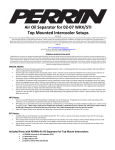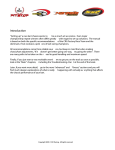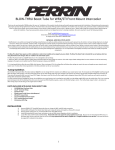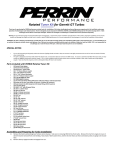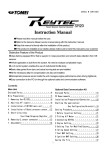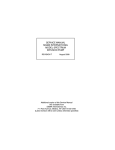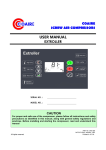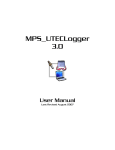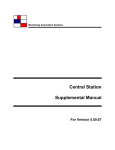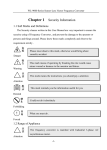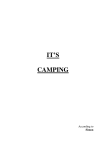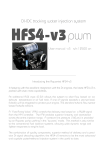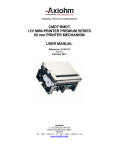Download Here - PDXTuning.com
Transcript
PDXTuning PDXTuning PDXTuning PDXTuning PDXTuning PDXTuning PDXTuning PDXTuning PDXTuning The Quick Guide To Subaru Tuning with the UTEC Sponsored by PDXTuning, Inc. http://www.pdxtuning.com The Ginge’s UTEC tuning experience As of 12/02/2004 PDXTuning PDXTuning PDXTuning PDXTuning PDXTuning PDXTuning PDXTuning PDXTuning PDXTuning I would like to thank PDXTuning, http://www.pdxtuning.com for sponsoring this update to the UTEC Quick Tune Guide. I had a WRX in the UK and when they were released in the U.S I was one of the first people in Portland Oregon to own one. A Sedona red wagon. After thrashing the hell out of it for 10 months I decided that I wanted to add some performance modifications to it. The usual stuff, larger turbo, bigger injectors, full exhaust system. At that point I decided that if I was going to invest in performance modifications I should do it to a virgin WRX. So over a lunch break I visited my local Subaru dealership and purchased myself a new 2003 sonic yellow wagon. This all happened in August 2002. By 600 miles I was almost a full stage 4 car thanks to my friends at Perrin. The issue was engine management, I had none as I was eagerly waiting the release of the TurboXS UTEC. When I finally got my UTEC I took my car into our local 4x4 dyno at Matrix Engineering and did a couple of base runs…… Shite, 189 WHP from a stage 4 car, this was running the TurboXS stage4 map at 17psi. I knew the car was way more powerful than that, I just needed to do some tuning. After many many hours of dyno tuning and road tuning I have a WRX that puts down 270 WHP at 19psi boost on 92 octane fuel constantly. VF30, Sti Pink Injectors, Perrin intake, uppipe, HKS down pipe, headers, PWR TMIC, Aquamist water injection just to name a couple of the main performance parts. The cars at 303 WHP now with a 20% toluene mix, it’s tuned to 12.5:1 AFR as I am running an Aquamist water injection setup. What follows is my tuning experience. It’s not complete, it’s not always 100% accurate, it’s just what I experienced while tuning my car. 1 PDXTuning PDXTuning PDXTuning PDXTuning PDXTuning PDXTuning PDXTuning PDXTuning PDXTuning PDXTuning PDXTuning Hello from Sarah and Mick PDXTuning PDXTuning PDXTuning PDXTuning PDXTuning PDXTuning PDXTuning Hello from Sarah and Mick. A couple of pictures of my car. From top left, On the golf course front view, on the golf course side view, a little bit of track racing at Portland International Raceway, my lovely wife Sarah and I at the Oregon Coast, dash board with touch screen LCD for UTEC tuning, EcuTek reflashing, Delta Dash logging, JDM 6 speed required for extra power, another action shot from Portland International raceway, Exedy 3 puck ceramic clutch, huge water tank that feeds the Aquamist water injection system and intercooler/oil/tranny cooler sprayers. I’m mick_the_ginge on most of the forums. 2 PDXTuning PDXTuning PDXTuning PDXTuning PDXTuning PDXTuning PDXTuning PDXTuning PDXTuning Updates • 09/07/2003 – Initial Version • 02/26/2004 – Added information on 4.1 firmware release • 03/22/2004 – Started Adding notes pages! • 12/02/2004 – Clean up and added some additional information (Trip to the UK and back) PDXTuning PDXTuning PDXTuning PDXTuning PDXTuning PDXTuning PDXTuning PDXTuning PDXTuning Did you know that I wrote the Quick Guide on planes over multiple business flights. I started adding these notes pages coming back from Barbados after my honeymoon, Sarah says hello. 3 PDXTuning PDXTuning PDXTuning PDXTuning PDXTuning PDXTuning PDXTuning PDXTuning PDXTuning The UTEC User Tunable Engine Computer Override control of: Fueling Timing Boost PDXTuning PDXTuning PDXTuning PDXTuning PDXTuning PDXTuning PDXTuning PDXTuning PDXTuning The UTEC allows you to control the main aspects of your car, Fuel, Timing and Boost. With the 4.1 firmware release the UTEC is looking more and more like a standalone ecu as it now contains it’s own open loop fueling map. This is a nice features as your AFR’s will be much more constant as your fueling with this mode enabled is based off a constant. 4 PDXTuning PDXTuning PDXTuning PDXTuning PDXTuning PDXTuning PDXTuning PDXTuning PDXTuning Expectations • What you are going to learn The basics required to tune with the UTEC • What you are NOT going to learn • Real WRX tuning! • Caution: This will be enough information to destroy your WRX! • ** READ THE UTEC USER MANUAL ** • This quick guide does not replace it PDXTuning PDXTuning PDXTuning PDXTuning PDXTuning PDXTuning PDXTuning PDXTuning PDXTuning Read this then read it again. The UTEC gives you enough control of your car to destroy it. This guide is a small addition to the TurboXS users manual. 5 PDXTuning PDXTuning PDXTuning PDXTuning PDXTuning PDXTuning PDXTuning PDXTuning PDXTuning Just in case you did not read the last bullet on the previous page PDXTuning PDXTuning PDXTuning PDXTuning PDXTuning PDXTuning PDXTuning PDXTuning PDXTuning Just checking to make sure you understand that you still have to read the manual. 6 PDXTuning PDXTuning PDXTuning PDXTuning PDXTuning PDXTuning PDXTuning PDXTuning PDXTuning PDXTuning PDXTuning Agenda • • • • • UTEC Overview Basic WRX Tuning theory UTEC Control and TPS Calibration UTEC and knock Map Tuning • Fuel – 0% tuning and Open Loop Fueling • Timing, Boost, Parameters • • • • PDXTuning Logging Spare Solenoid Usage Handy software applications FAQ’s PDXTuning PDXTuning PDXTuning PDXTuning PDXTuning PDXTuning Agenda, duh. 7 PDXTuning PDXTuning PDXTuning PDXTuning PDXTuning PDXTuning PDXTuning PDXTuning PDXTuning UTEC Overview • How does the UTEC enable more Horse Power? • Increases/decreases fuel • Advances/retards timing • Control over boost pressure PDXTuning PDXTuning PDXTuning PDXTuning PDXTuning PDXTuning PDXTuning PDXTuning PDXTuning Subaru knows they can extract way more power out of the WRX engine, but for reliability they choose not to. The main consumer wants a car to last 100,000+ miles and a very high performance car just won’t do that. Thus Subaru makes the WRX fast, but not that fast. Power is left on the table and the UTEC allows you to extract that extra power buy modifying fuel, timing and boost curves. A UTEC on a stock car can add 30 WHP with ease. Bang for the buck, engine management on a stock car is the way to go. Once you start adding more performance parts the UTEC becomes invaluable as you have to tune to make the most of those new parts. Just take my car for example, 189 WHP with a full stage4 set of parts, 270 after correct UTEC tuning. 8 PDXTuning PDXTuning PDXTuning PDXTuning PDXTuning PDXTuning PDXTuning PDXTuning PDXTuning Basic WRX Tuning theory Modify Fuel Higher EGT’s (Less Fuel to air ratio) More prone to knock Advance timing More prone to knock (Fuel ignited earlier) Higher Boost Higher EGT’s (Higher boost PSI) More prone to knock PDXTuning PDXTuning PDXTuning PDXTuning PDXTuning PDXTuning PDXTuning PDXTuning PDXTuning Actually this is basic tuning theory. Fuel: 12.5:1 Air Fuel Ratio, AFR produces more power that say 10:1 AFR. That’s 12.5 parts air to 1 part fuel. Leaner can produce more power but you can go too lean that is very bad for the engine. The negative effects of leaner AFR’s are hotter Exhaust Gas Temperatures, EGT’s which also means your car is more prone to knock. Knock is bad and we will talk about this more in the coming sections. I like to target 11:1 at 5000 tapering down to 10.5:1 at readline. Advancing the timing, making the spark ignite the fuel more degrees before top dead center can also lead to more power. Again, more advance also makes your engine more prone to knock. As soon as you get knock you know that you are far past Minimum Best Timing, MBT, and you make no extra power past MBT. I prefer to run more conservative timing and more boost and fuel. More boost means more power only when you can add enough fuel for that amount of boost. Again more boost can lead you to be more prone to knock. 9 PDXTuning PDXTuning PDXTuning PDXTuning PDXTuning PDXTuning PDXTuning PDXTuning PDXTuning UTEC Control • Fuel • Based on Throttle position, TPS, versus (RPM or MAP) • Timing • Based on Throttle position, TPS, versus (RPM or MAP) • 0% column applies to all RPM’s below TPS cross over point • Past cross over point 10%-100% columns represent MAP as set in the SPECIAL CONSTANTS • Below Cross over it’s TPS • Boost • Based on Throttle position versus RPM PDXTuning PDXTuning PDXTuning PDXTuning PDXTuning PDXTuning PDXTuning PDXTuning PDXTuning Ok, so the basics. The UTEC is not always in control. Only over the default crossover throttle position does the UTEC take control. 60% in classic fueling mode and 25% open loop fueling mode. Under the crossover point the stock ECU is doing all the work. It controls the fueling, boost and the firing of the spark plugs. Past the crossover the UTEC talks control and is then based on a mixtures of boost pressure, MAP and with the new open loop fueling it can control via Mass Air Flow, MAF for the fuel as well. For now lets just think of RPM and MAP. The UTEC 10-100% map columns are based on RPM vs. MAP past the crossover point. The 0% column can be used to override the ECU values for the fueling, timing and boost while below the crossover points. The 0% could be as simple as telling the UTEC to use the ECU values or more complex such as apply a fueling override or lock down timing at specific RPM values. Boost is the odd one out, it’s throttle position vs. RPM based. 10 PDXTuning PDXTuning PDXTuning PDXTuning PDXTuning PDXTuning PDXTuning PDXTuning PDXTuning TPS Calibration • Why? • • Enables correct load point selection based on TPS How? • Modify values in SPECIAL CONSTANTS menu 1. Turn on Car, do NOT start car • Using Logger 4 – – Record TPS (T0) Full depress throttle, record TPS (T1) 2. Min TPS = T0 / 51 3. Max TPS = T1 / 51 TIP: Seeing just over 100% is OK If TPS never reads 100% you will never reach the 100% load column And TPS/RPM to RPM/MAP cross over point will be incorrect! PDXTuning PDXTuning PDXTuning PDXTuning PDXTuning PDXTuning PDXTuning PDXTuning PDXTuning TPS Calibration is simple to do and means your load points will always be correct. 11 PDXTuning PDXTuning PDXTuning PDXTuning PDXTuning PDXTuning PDXTuning PDXTuning PDXTuning UTEC and Knock • UTEC only corrects knock when it is in control of timing: • TPS > Crossover • Timing retarded by 2 degrees for 100 crank cycles • Continues to retard timing until knock is no longer detected • Very sensitive Knock/Detonation is the spontaneous combustion of the end-gas (remaining fuel/air mixture) in the chamber. This occurs after the spark. • Which is a good thing!! PDXTuning PDXTuning PDXTuning PDXTuning PDXTuning PDXTuning PDXTuning PDXTuning PDXTuning One of the very cool things the UTEC can do is detect knock very well. The stock ECU also detects knock but stops listening for knock at around 5500 rpm. The UTEC while in control is always listening for knock and will retard the ignition if knock is detected. This is great as it gives you a reliable fail safe all the way to redline. Uncorrected knock will kill your car. If you get knock, let off, don’t try to drive though it. Knock can destroy an engine! Extreme cylinder pressures are seen when knock occurs. It’s this extreme pressure that destroys the engine, easily breaking connecting rods and bearings. The UTEC is pretty sensitive to knock which is a good thing. I suggest that you do not mess with the knock thresholds, they are set like that for a reason. I have seen cars pull way over 425 WHP on those knock settings so they work just fine. When the UTEC detects knock you can be pretty sure that knock is what you got. Fix the condition, do not reduce the knock sensitivity. Too much timing advance is the #1 culprit of knock conditions. Simple knock cures are less timing advance and more fuel. Remove the timing first, 2-3 degrees, then try adding fuel. Your car will be less prone to knock with a better grade of fuel. The more octane the fuel has the better. 12 PDXTuning PDXTuning PDXTuning PDXTuning PDXTuning PDXTuning PDXTuning PDXTuning PDXTuning PDXTuning PDXTuning PDXTuning Map Tuning Fuel Timing Boost Parameters PDXTuning PDXTuning PDXTuning PDXTuning PDXTuning PDXTuning Now for the real stuff 13 PDXTuning PDXTuning PDXTuning PDXTuning PDXTuning PDXTuning PDXTuning PDXTuning PDXTuning Fuel Tuning Information applicable to classic MAF modification in 3.1 and 4.1 mode and Open Loop Fueling mode PDXTuning PDXTuning PDXTuning PDXTuning PDXTuning PDXTuning PDXTuning PDXTuning PDXTuning Fuel tuning with the UTEC has 2 modes. One is based off the ECU fueling map, the other is based off the UTEC’s built in MAF based fueling map, this mode is known as open loop fueling. The following information relates to both of these modes. As a side note this quick guide is not setup in the order that I actually tune in. I load a conservative fuel and timing map then I setup the desired boost curve. I monitor the AFR’s as I do this to makes sure the car is not running lean. Once I have the boost sorted out I then start to tune the fuel to the desired AFR targets. Finally I adjust timing to squeeze that extra little bit of power out of the engine. 14 PDXTuning PDXTuning PDXTuning PDXTuning PDXTuning PDXTuning PDXTuning PDXTuning PDXTuning Know your MAP based load points • Settings found in SPECIAL CONSTANTS menu • Defined as • Min PSI (0 default) • Max PSI (18 default) Load Column Min PSI Max PSI 10% 0.0 2.0 20% 2.0 4.0 30% 4.0 6.0 40% 6.0 8.0 50% 8.0 10.0 60% 10.0 12.0 70% 12.0 14.0 80% 14.0 16.0 90% 16.0 18.0 100% 18.0 18+ Modify Max PSI setting to your desired PSI This will effect your fuel tuning PDXTuning PDXTuning PDXTuning PDXTuning PDXTuning PDXTuning PDXTuning PDXTuning PDXTuning Simple, know you load points. When logging you will see loads of data, the most important of these are the rpm and Map Load Point, MLP for short. The MLP is based off the Manifold Absolute Pressure, MAP. The MLP is a range from 0-100%. The above chart shows how the MLP corresponds to MAP if the UTEC defaults are used. For most cars the defaults can be used. The load point or load zone as it is sometimes called is very important data for tuning. When analyzing UTEC log files look at the RPM values and the load point to work out which cell was in use. In the logger files you will sometimes see that the MAP lags behind the MLP. Trust the MLP, it reflects what cell the UTEC is actually using at that time. The logger MAP values are averaged to ease analysis. Tune using the RPM and MLP…. The UTEC always uses absolute pressure even if the logger is set to gauge. 15 PDXTuning PDXTuning PDXTuning PDXTuning PDXTuning PDXTuning PDXTuning PDXTuning PDXTuning Caution When Fuel Tuning • Stock O2 sensor is wideband but it’s not recommended to tune against it under WOT • Do not use the WOT AFR reading to tune! • Even when UTEC log reads rich, AFR maybe as high as 12.5:1 (Far too lean without water injection) • Lean AFR’s lead to high If in doubt go RICH (But not too rich as that will cause misfire) PDXTuning PDXTuning PDXTuning PDXTuning EGT’s and possible engine damage • Tune fuel using a real wideband O2 sensor PDXTuning PDXTuning PDXTuning PDXTuning PDXTuning The stock WRX front O2 sensor is wideband but you must not tune against the AFR you read from it. It’s only wideband to enable the ECU is to run in closed loop fuel tuning mode. This is where the ECU monitors the front O2 sensor and try’s to keep the AFR’s at as close to 14.9:1 AFR as possible. The ECU is only in this mode under certain easy driving conditions and the sensor works great within those regions. Outside of these regions the wideband is ignored by the ECU and it runs on open loop mode. Using delta dash I can see that the sensor pegs at about 11.5:1, the UTEC logs read rich under about 12.5:1. I do not trust the stock sensor and highly recommend an aftermarket wideband O2 setup. Loads of good ones around, the Tech Edge setup, TurboXS Tuna and the LM1’s. I have a Tech Edge setup and a TurboXS Tuna. I must admit I like the Tuna as the wideband value is displayed right in with the UTEC logs. I use the new Autologger available for download from www.wrxhackers.com that allows the Tech Edge wideband reading to be logged along side of the UTEC logs. Very nice. Anyway, buy or borrow a wideband to enable you to tune your fuel correctly. 16 PDXTuning PDXTuning PDXTuning PDXTuning PDXTuning PDXTuning PDXTuning PDXTuning PDXTuning Tuning the 0% column for NONstock injectors 0% column applies to all RPM’s below TPS crossover • If you have larger than stock injectors you should tune your 0% column using an OBDII Scanner • Effects ECU’s Long Term and Short Term trim values • Typical Stage4 map yields LT values from +20 to –20% • Fine to be within –7% to +7% (I think that -7% to 0 is better) • This is not required if you’re still using the stock injectors • Add/remove a percentage of MAF to get the trims in line. PDXTuning PDXTuning PDXTuning PDXTuning PDXTuning PDXTuning PDXTuning PDXTuning PDXTuning If you are running larger than stock injectors you will have to tune your 0% fuel column. Your goal is to get the ECU’s short and long term fuel trim values as close to 0 as possible. The UTEC cannot read the ECU fuel trims, an ODBII scanner or other logging device such as delta dash can be used to capture the fuel trim values. The ECU can only correct +-25% fueling to compensate for injectors. If you install STi injectors without engine management you will see that the ECU will max out both ST and LT trims at –25. The ECU is trying to remove loads of fuel to compensate for the larger injectors. The UTEC 0% column is used to fool the ECU into thinking that less air is going into the engine thus the injectors do not need to be fired so much. Getting the ST and LT trims under control will lead to a more stable idle and better overall fuel tune. In 3.1 fueling mode getting the ST and LT trims under control is very important. 17 PDXTuning PDXTuning PDXTuning PDXTuning PDXTuning PDXTuning PDXTuning PDXTuning PDXTuning Tuning the 0% column for NONstock injectors – Open loop fueling 0% column applies to all RPM’s below TPS crossover • When using open loop fueling the UTEC automatically does 0% fueling compensation. • The value used is calculated from the difference between the Stock injector size and the UTEC injector size • The larger the difference the more modification is done. • Follow the attached notes to work out how to really do it. PDXTuning PDXTuning PDXTuning PDXTuning PDXTuning PDXTuning PDXTuning PDXTuning PDXTuning Stock intake or normal sized aftermarket. Say the UTEC stock injector size is set to 400 and the UTEC size is set to 500. This means the UTEC injector size is larger than stock thus the UTEC will remove fuel from the 0%. The larger the difference the more fuel the UTEC will want to remove. It’s actually doing an automatic MAF modification for you. If you have a reflashed ECU for your setup the stock size should match the UTEC size. The UTEC size will be the actual size of your injectors. I think in the future the UTEC will directly calculate the injector duty cycle even in the 0% rather than doing the modification as a MAF offset. BigMAF setups. If you have a BigMAF then it’s a little more complex to work out the values. A bigMAF will flow more air so you cannot use the actual injector size as the UTEC injector size. With a BigMAF it will always be smaller than what you have installed. Remember the UTEC does not know you have a BigMAF and it will fuel based on a stock intake. For example if you have an Sti with Perrin 816 injectors and a BigMaf then I find that setting the UTEC injector size to 650 gets you close. Leave the stock size at 550. If you look at the fuel trims and they are either too positive or too negative change the stock injector size. Have the stock size closer to the UTEC size will mean less fuel is removed. Do this if the trims are positive. More difference will force the UTEC to remove more fuel, do this if the trims are negative. 18 PDXTuning PDXTuning PDXTuning PDXTuning PDXTuning PDXTuning PDXTuning PDXTuning PDXTuning Tuning the 0% column – Simple Tuning Procedure #1 • Warm the car up • Reset the ECU • While in neutral • Rev car from idle to 5000+ RPM while logging LT and ST • Adjust 0% to add/remove fuel where needed – If LT and ST show positive, ADD fuel – If LT and ST show negative, REMOVE fuel • Reset ECU and Repeat • Do this until LT and ST read close to 0 PDXTuning PDXTuning PDXTuning PDXTuning PDXTuning PDXTuning PDXTuning PDXTuning PDXTuning Follow these simple notes to tune your 0% UTEC MLP. 19 PDXTuning PDXTuning PDXTuning PDXTuning PDXTuning PDXTuning PDXTuning PDXTuning PDXTuning Tuning the 0% column – Simple Tuning Procedure #2 • Go drive the car while logging LT and ST • Under load fuel conditions are different • Again adjust 0% column to try and get LT and ST as close to 0 as possible • It’s never going to be perfect, but it should be close TIP: At Idle force ECU to be removing fuel. Idle seems to run smoother PDXTuning PDXTuning PDXTuning PDXTuning PDXTuning PDXTuning PDXTuning PDXTuning PDXTuning Forcing the ECU to take the LT negative at idle does seem to give you a very stable idle but don’t go too far. The transition to your idle 0% setting leads to a rich spot as the ecu transitions into that load zone. Too rich at this point and your car will stall. 20 PDXTuning PDXTuning PDXTuning PDXTuning PDXTuning PDXTuning PDXTuning PDXTuning PDXTuning Delta Dash Log of 0% Tune Very stable idle Nice and stable LT ST not too bad Effect of free air BOV Short Term Long Term PDXTuning PDXTuning PDXTuning PDXTuning PDXTuning PDXTuning PDXTuning PDXTuning PDXTuning This is a Delta Dash log from a quick run. Notice the ST trim jumps around loads. This is normal as the ECU is on closed loop fuel control and uses ST to make quick fuel adjustments. If a ST pattern is spotted by the ECU it uses the more coarse LT trim value to apply a more permanent adjustment. This is called fuel learning and the ECU is very good at it. It’s typical to see steps in the LT trim values. Notice the ST spike, that’s the BOV venting producing a rich condition. The ECU is back in closed loop fuel tuning mode and immediately tries to correct the condition, thus the negative spike on the ST trim. 21 PDXTuning PDXTuning PDXTuning PDXTuning PDXTuning PDXTuning PDXTuning PDXTuning PDXTuning Knock after shift (fuel correction) Add some fuel in these areas to minimize knock after shift • Knock after shift is usually down to two things • #1 Lean conditions just after shift • #2 Large jump in timing just after shift • Adding fuel at 5000+ RPM’s in the lower boost range can minimize this effect • Having timing values down in the lower columns also helps PDXTuning PDXTuning PDXTuning PDXTuning PDXTuning PDXTuning PDXTuning PDXTuning PDXTuning While we are on the subject of the 0% column I should also mention something that is being called shift knock. Shift knock is knock that is detected between shifts. This type of knock is down to a couple of conditions. The first is the lean condition that happens as you shift the second is the timing that the ECU runs during the shift. Both the lean condition and the high timing advance lead to knock. These two effects happen when the UTEC gives back control to the ECU. Both knock conditions can be fixed by locking down fueling and timing in the 0% column. To reduce the chance of shift knock add some extra fuel in the 0% column from around 5000 rpm and up. Don’t worry about the fuel trim values, the ECU is in open loop mode at 5000 rpm so the extra fuel will not effect them. This extra fuel reduces the lean condition thus reducing the risk of shift knock. Watch out, if you add too much fuel in this area you could end up with some meaty backfire due to un-burnt fuel in the exhaust. This will damage cats and could also be miss sensed as knock. Also if you happen to do a low load run up to these high rpm’s this extra fuel could cause misfires. 22 PDXTuning PDXTuning PDXTuning PDXTuning PDXTuning PDXTuning PDXTuning PDXTuning PDXTuning PDXTuning PDXTuning Fuel Tuning OPEN LOOP FUELING Mode PDXTuning PDXTuning PDXTuning PDXTuning PDXTuning PDXTuning PDXTuning More on fuel tuning 23 PDXTuning PDXTuning PDXTuning PDXTuning PDXTuning PDXTuning PDXTuning PDXTuning PDXTuning Fuel Map Tuning 0% column applies to all RPM’s below TPS cross over point PDXTuning PDXTuning PDXTuning Past cross over point, Throttle > 25%, load is represented by Mass Absolute Pressure, MAP as defined in the SPECIAL CONSTANTS PDXTuning PDXTuning PDXTuning PDXTuning PDXTuning PDXTuning Just a recap. Under the TPS crossover point the 0% fueling values are used. Over the crossover point the 10-100% load columns are used and the load reference swaps to MAP. 24 PDXTuning PDXTuning PDXTuning PDXTuning PDXTuning PDXTuning PDXTuning PDXTuning PDXTuning Fuel Tuning Table • More positive numbers represent more fuel • A value of 2 is more fuel than an value of 1 • A value of –6 is less fuel than a value of –5 • Get the drift……… You are modifying the Mass Air Flow, MAF, voltage reading by a percentage Applies to both classic and open loop fueling modes PDXTuning PDXTuning PDXTuning PDXTuning PDXTuning PDXTuning PDXTuning PDXTuning PDXTuning The values that you type into the fuel map do NOT represent injector duty cycle they represent a MAF offset percentage. This is the same in both fueling modes whether the ECU is controlling the background fuel map or if the UTEC is running in open loop fueling mode and is controlling the background map. A more positive number represents more fuel, a more negative number represents less fuel. 25 PDXTuning PDXTuning PDXTuning PDXTuning PDXTuning PDXTuning PDXTuning PDXTuning PDXTuning Fuel Tuning >TPS crossover Fueling for Rapid Spool Up Always use a Wideband O2 sensor to tune your fuel values! Over TPS crossover - UTEC load swaps to MAP Keep Low RPM and Low Boost Fuel values on the leaner side This creates HOTTER EGT’s which helps the turbo spool quicker Richen up fuel at mid RPM and mid boost (Safer for your WRX if you don’t have water injection) My AFR target was 12.5:1 up until 2750 RPM PDXTuning PDXTuning PDXTuning PDXTuning PDXTuning PDXTuning PDXTuning PDXTuning PDXTuning Far too often I see threads about slow spool up on the WRX turbo or after market turbo’s with the UTEC. With after market turbo’s some of this is because the things are huge and do have a slow spool up. Some of it is due to the car running really rich in the spool up zones. The UTEC base maps are good but they can be a little rich. This is great and conservative but can lead to slow turbo spool up as the EGT’s don’t get very hot. If you have this issue you should use a wideband O2 sensor and see if you are running rich in the spool up area. 10.5:1 maybe perfect at full boost but 12.5:1 AFR will create hotter EGT’s and aid spool up. Do not lean this area out too much as you will end up losing power. 26 PDXTuning PDXTuning PDXTuning PDXTuning PDXTuning PDXTuning PDXTuning PDXTuning PDXTuning Fueling Part 2 Always use a Wideband O2 sensor to tune your fuel values! AFR data is coming from Wideband Not shown. Much easier with a TXS “Tuna”, AFR data right in the log file Log to correlate AFR/RPM/MAP data back to UTEC load column reference Adjust column to meet target AFR My AFR target was 11.5:1 PDXTuning PDXTuning PDXTuning PDXTuning PDXTuning PDXTuning PDXTuning PDXTuning PDXTuning Funny after all those slides this is the most important. Here you can see a snippet from a UTEC log 1. I was not using the Tuna for this run so you cannot see the AFR data. AFR data was in a separate log from my Tech Edge wideband. To tune you should reference the rpm and the map load points. The MLP’s are highlighted in the above slide. From the RPM and MLP work out which load cell to modify to either add or subtract fuel at that point. I try are target 12:5:1 up to 2750, then come down to 11.5:1 up to 5000 and finally down to 11:1 at redline. Remember to add fuel make the value more positive and to subtract fuel make the value more negative. If you have water injection you should be able to run leaner at the top end. 12:1… sweet. While you are fuel tuning check the injector duty cycle. If it’s already at 100% and you are running too lean then you will have to turn the boost down at that point. Once the injectors hit 100% you cannot add anymore fuel. Notice that you do not enter all of the load zones. You kind of go into ranges of them. This is typical as unless you have access to a load set dyno it’s hard to tune all load zones. For ranges above a zone that are not entered I always go richer and for ranges below a zone that are not entered I always go leaner. Not much either way. Daily driving I enter these other load zones and always check that I’m running more on the rich side than the lean side. 27 PDXTuning PDXTuning PDXTuning PDXTuning PDXTuning PDXTuning PDXTuning PDXTuning PDXTuning Knock correction and Fuel Tuning • Add fuel to correct knock conditions • WRX typical problem areas • Around 4000 RPM • Around 5500 RPM • Stage4 Map example • Rich around 4000 RPM Caution: Too much fuel will lead to misfire PDXTuning PDXTuning PDXTuning PDXTuning PDXTuning PDXTuning PDXTuning PDXTuning PDXTuning The WRX has a couple of points that seem to be more prone to knock than others, around 4000 and 5500 rpm’s. This I am sure is down to engine design. The knock issues can be reduced by adding a little extra fuel in these areas. You can see these area’s in the timing map as well. Just look at the lower timing values at these points. Do not add too much fuel, just a tad. The hesitation that some people feel with their cars is typically down to running too rich in an area. Just a little extra fuel to help reduce knock conditions. 28 PDXTuning PDXTuning PDXTuning PDXTuning PDXTuning PDXTuning PDXTuning PDXTuning PDXTuning PDXTuning PDXTuning Fuel Tuning New in 4.1 - Open Loop Fueling Mode PDXTuning PDXTuning PDXTuning PDXTuning PDXTuning PDXTuning PDXTuning Oh, oh, the new Open Loop Fueling mode of the UTEC. I was one of the lucky ones who got to do some early testing of it. AFR’s are way more constant using OLF. 29 PDXTuning PDXTuning PDXTuning PDXTuning PDXTuning PDXTuning PDXTuning PDXTuning PDXTuning Why Open Loop Fueling • Eliminates the delay in transitioning from closed to open loop fuel control in the stock ECU. • Big issue with the 2004+ WRX ECU. • Enables Programmable Rev limit • Enables injector scaling • Eases fuel tuning when larger than stock injectors are installed • Do not use scaling with a classic style fuel map. PDXTuning PDXTuning PDXTuning PDXTuning PDXTuning PDXTuning PDXTuning PDXTuning PDXTuning The #1 reason the UTEC need to do full fuel control is due to the 2004 WRX closed to open loop transition delay. Basically what was happening was that the ECU was programmed with a delay between closed loop fueling and open loop fueling. In closed loop ECU fueling it tries to target 14.9:1 reading the front O2 sensor. The delay was going into open loop mode where the ECU just has a fuel background map. This delay caused the car to run really lean going onto boost. Knock, knock……. Anyway with the UTEC Open Loop Fueling this issues goes away as the UTEC is creating the background fuel map. This is very cool as it’s MAF based. As soon as you go over the TPS crossover point which the default for OLF is 25% the UTEC is in control. Hence the delay is not an issue as the ECU is now doing nothing. 2 other features are the controllable rev limit and the injector scaling. Injector scaling will help those with larger than stock injectors. If you are using STi injectors don’t use the scaling. Lets face it there are many maps available for these injectors already. Stick with the default scaling and use a standard map. You can still use OLF without injector scaling. Also don’t expect to be able to install 740’s and just set the scaling. It requires more work than that. DO NOT USE INJECTOR SCALING WITH A CLASSIC STYLE MAP>>>>> 30 PDXTuning PDXTuning PDXTuning PDXTuning PDXTuning PDXTuning PDXTuning PDXTuning PDXTuning What is Open Loop Fueling? UTEC MAF BASED FUELING Full fuel control, not an offset of the ECU fueling No longer have to worry about effects of the Long Term Fuel Trim value CONSITENT FUELING, no more long term trim offset MAF base fueling UTEC calculates injector duty cycle based on MAF/RPM a UTEC is in full control of fueling PDXTuning PDXTuning PDXTuning PDXTuning PDXTuning PDXTuning PDXTuning PDXTuning PDXTuning Open loop fueling is just a name for the UTEC being in full control of the injectors. Previously the UTEC fueling was an offset of the ECU fueling. The issues with this was if the ECU changed it fueling the UTEC fueling got screwed up. This could happen if the long term trim value changed over time. With OLF the UTEC when in control creates the background map to replace everything that the ECU is doing in respect to fuel. To do this the UTEC reads the MAF signal to calculate the injector duty cycle. Very cool and it takes the UTEC one step closer to being a standalone ECU. 31 PDXTuning PDXTuning PDXTuning PDXTuning PDXTuning PDXTuning PDXTuning PDXTuning PDXTuning Turning on Open Loop Fueling • Requires 4.1 or above firmware • To enable: • Enter the Open Loop Fueling menu option • Turn on Open Loop Fueling. Change to be 1 – On by default in 4.2c and above – New base maps from TurboXS are tuned for OLF Screen parameters may have changed a little since this screen shot was taken PDXTuning PDXTuning PDXTuning PDXTuning PDXTuning PDXTuning PDXTuning PDXTuning PDXTuning Enabling OLF is easy. GO into the OLF menu option of the 4.1 or above firmware and turn OLF to 1. Even if you have STi injectors DO NOT MODIFY THE INJECTOR FLOW. DO NOT MODIFY THE INJECTOR FLOW (scaling) - DO NOT MODIFY THE INJECTOR FLOW - DO NOT MODIFY THE INJECTOR FLOW With OLF enabled I suggest you re-check your AFR’s with a wideband. The OLF background fuel map is close to what the ECU does but not exactly what it does. I noticed that I actually ran leaner at lower load zones and much richer at the top end. But the differences were within acceptable ranges so I stuck with my original map. STI Injectors and larger. The reason that you do not change the Injector flow scaling value is that the map you are running was designed to compensate for stock ECU fueling with larger injectors installed. If you change the flow scale are run a map that has negative values you are going to run super lean.. 32 PDXTuning PDXTuning PDXTuning PDXTuning PDXTuning PDXTuning PDXTuning PDXTuning PDXTuning Default OLF Operation • If injector flow has not been adjusted then classic style Fuel Maps are compatible when Open Loop Fueling is enabled • Fueling will be much more consistent • Default cross over into OLF is 25% TPS • Resolves 2004 WRX closed/open transition issues You may have to re-tune some of your lower load point Why? Because before this you may have never been running through these lower load points PDXTuning PDXTuning PDXTuning PDXTuning PDXTuning PDXTuning PDXTuning PDXTuning PDXTuning Not much to say here. OLF is not for everyone but with some extra fuel tuning the results are a more constant fuel tune. 33 PDXTuning PDXTuning PDXTuning PDXTuning PDXTuning PDXTuning PDXTuning PDXTuning PDXTuning Changing Injector Flow Scaling • Requires 4.1 or above firmware • To enable: • Enter the OLF menu option • Modify Injector Flow: – Supports 300 to 1000 flow rate – 500 – 560 seems to work for STi Injectors • When a Stock style air box is used! PDXTuning PDXTuning PDXTuning PDXTuning PDXTuning PDXTuning UTEC generates AFR curve based on MAF/RPM and scaling factor PDXTuning PDXTuning PDXTuning With your new map loaded you can change the injector flow value. You can’t just enter the flow rate of your injector and expect everything to be perfect. I run the Perrin intake and STI injectors and I ended up using a value of 500 just to get close to a good starting point. If you have a larger than stock intake you will have to be very careful with the value you enter. Too large and your car is going to run lean even with the map zero. Start low and work up. 34 PDXTuning PDXTuning PDXTuning PDXTuning PDXTuning PDXTuning PDXTuning PDXTuning PDXTuning Modified Stock Injector Flow Scaling • Start with a low value • The injectors may flow 740cc but do they match your MAF readings • You maybe flowing more air! BigMaf for example • Start with injector flow set at 700 (guess) • Increase this value while monitoring AFR curve with wideband O2 sensor • Fine tune AFR curve using a map overlay • Next page ☺ PDXTuning PDXTuning PDXTuning PDXTuning PDXTuning PDXTuning PDXTuning PDXTuning PDXTuning Just a reminder that you cannot just enter a flow value and expect everything to work as expected. Modified stock injectors are a great thing for those who need more fuel but even with the UTEC injector scaling you are going to have to fine tune you fuel map. 35 PDXTuning PDXTuning PDXTuning PDXTuning PDXTuning PDXTuning PDXTuning PDXTuning PDXTuning Modifying Scaled OLF AFR Curve • Fine tune AFR curve by adjusting fuel map in standard fashion. • Minus fuel to lean sections of curve • Add fuel to richen Example Only sections of curve PDXTuning PDXTuning PDXTuning PDXTuning PDXTuning PDXTuning PDXTuning PDXTuning PDXTuning Once you have the injector scaling near where you want it to be you can go back to the standard way of fuel tuning and enter some MAF offset values to fine tune the AFR curve. When I tested this a set my injector scaling at a value that produced a rich AFR curve across all the rpm ranges. I then fine tuned the curve by removing fuel from a couple of spots. I preferred to do it this way as the load zones that are not covered in a test run you kind of know that they will be running rich rather than lean. Even though you are using a MAF offset method to adjust the fueling it will still be very consistent as the background map is generated by the UTEC, not the ECU that can drift over time. 36 PDXTuning PDXTuning PDXTuning PDXTuning PDXTuning PDXTuning PDXTuning PDXTuning PDXTuning Programmable Rev Limit • Now UTEC controls fueling, it can also control rev limit – Way cool ☺ • Warning: Unless you have strengthened internals changing rev limit could cause serious engine damage PDXTuning PDXTuning PDXTuning PDXTuning PDXTuning PDXTuning PDXTuning PDXTuning PDXTuning Final note on the programmable rev limit. For those who want to run a little past the ECU set rev limit at 7200 you can with this new feature. Don’t get stupid with this setting. The stock internals were not made to run at 9000 rpm so don’t go their. I like to shift at 7000 rpm and noticed that with the 200 rpm offset of the tachometer I would hit rev limit during a hard shift. My solution was to up the rev limit to 7500. Very sweet shifts now with the launch control set at 6000 perfect for flat foot shifting. 37 PDXTuning PDXTuning PDXTuning PDXTuning PDXTuning PDXTuning PDXTuning PDXTuning PDXTuning PDXTuning PDXTuning Timing Tuning Timing ninja fu PDXTuning PDXTuning PDXTuning PDXTuning PDXTuning PDXTuning PDXTuning Time to talk about timing. 38 PDXTuning PDXTuning PDXTuning PDXTuning PDXTuning PDXTuning PDXTuning PDXTuning PDXTuning Timing Map Tuning 0% column applies to all RPM’s below TPS cross over point PDXTuning PDXTuning PDXTuning Past cross over point, Throttle load is represented by Mass Absolute Pressure, MAP as defined in the SPECIAL CONSTANTS PDXTuning PDXTuning PDXTuning PDXTuning PDXTuning PDXTuning Again a reminder. The 0% column is used when you are blow the TPS crossover. Once over this point the 10-100% load columns are used and the reference is swapped to MAP. 39 PDXTuning PDXTuning PDXTuning PDXTuning PDXTuning PDXTuning PDXTuning PDXTuning PDXTuning Timing Advance / Retard Retard Timing – Less degrees before TDC Number of Degrees before top dead center Piston Advance Timing – More degrees before TDC Cylinder Piston Top Dead Center, TDC PDXTuning PDXTuning PDXTuning PDXTuning PDXTuning PDXTuning PDXTuning PDXTuning PDXTuning Some basics. Top Dead Center is the upper most point the piston can ever reach. Timing is measured from this point. Advancing the timing is when you set the spark to happen before TDC as the piston is on it’s way up. This is measured in degrees. Retarding the timing is a phrase used to explain reducing the number of degrees before TDC that the spark happens. 40 PDXTuning PDXTuning PDXTuning PDXTuning PDXTuning PDXTuning PDXTuning PDXTuning PDXTuning Effects of timing adjustment More Power Advance Timing Spark ignites air/fuel mix MORE degrees before top dead center More Torque Higher EGT’s Less prone to knock PDXTuning PDXTuning PDXTuning PDXTuning Lower EGT’s More prone to knock Retard Timing Spark ignites air/fuel mix LESS degrees before top dead center PDXTuning PDXTuning PDXTuning PDXTuning PDXTuning More timing advance produces more power but in my eyes it is the #1 reason for engine damage. Too much timing advance is just like knock, it generates extreme cylinder pressures that end up breaking things. The advantage of more timing advance though is not only extra power but it also reduces EGT’s. Reducing or retarding the timing makes the car less prone to knock and can raise torque but can also raise EGT’s. As I said too much timing can be bad. There is this thing called Minimum Best Timing, MBT, I’m not go into great depth into what it is and why this happens but basically there is a point where adding more timing advance does not yield any more power. This point is known as minimum best timing. I have seen this on the dyno. I was trying to add power at one point in my map. My AFR’s were spot on so I started adding timing. At first I saw gains then it stopped. I continued to add timing, 2 then three degrees, nothing. Then I got knock at that exact spot. Basically I had gone past the minimum best timing point and all I was doing was raising the chances of knock. I removed 3 degrees of timing, lost no power and never saw knock at that spot again. The moral of this story is that if you get knock and your AFR’s are correct you have too much timing advance. You will not loss any power by removing 2-3 degrees at this point. This of course if also down to the octane rating of you petrol, (gas). More octane the petrol has the slower the flame front moves through the cylinder the more timing 41 PDXTuning PDXTuning PDXTuning PDXTuning PDXTuning PDXTuning PDXTuning PDXTuning PDXTuning Timing Adjustment • Issue: Default maps don’t have timing down in the 10-60% columns – Can cause knock when control passes from ECU to UTEC and back. Needed for cars with BigMAF • Resolution: Move timing values into those area • LEAVE lower RPM 0% under ECU control Smooth transitions in timing minimizes the chance of knock Try to limit steps in timing to less than 3 degrees PDXTuning PDXTuning PDXTuning PDXTuning PDXTuning PDXTuning PDXTuning PDXTuning PDXTuning Some of the issues that are seen with the base maps are that there is no timing values in the lower load zones. What happens is that as control is passed from the ECU to the UTEC the timing values can be vastly different. More than 4 degrees and you can feel it. This jerk sometimes also gets detected as knock. The solution is to put timing values into the lower load zones. Another issue that comes up with timing is what I like to call transitional knock. This is either the above scenario or when the UTEC is in control and timing jumps up or down more that 2 degrees at a time. In the lower load zones having jumps of 4-8 degrees in timing are fine, but under WOT boost conditions you should avoid this. Keep the timing steps to 1-2 degrees at a time. This limits the chances to transitional knock. I have no idea why the car does this, it just does. Smooth transitions up and down are key to a good feeling car. What I like about my car is that the power is always coming on and it feels very smooth. When I go to WOT the boost builds up in a controlled fashion and with smooth transitions in AFR and timing the car feels smooth. I have no hesitations or neck snapping jerks. No one has ever said that my car feels slow either. 42 PDXTuning PDXTuning PDXTuning PDXTuning PDXTuning PDXTuning PDXTuning PDXTuning PDXTuning Knock after shift (timing correction) Use conservative timing values in upper 0% column to minimize the chance of knock after shift ECU runs huge timing advance after high RPM shift. This can cause knock after shift conditions PDXTuning PDXTuning PDXTuning PDXTuning PDXTuning PDXTuning PDXTuning PDXTuning PDXTuning Earlier I mentioned that to cure shift knock you can add fuel in the upper 0% load columns. If you have what you think is shift knock you should also hard code some of the timing values in the upper load zones as well. If you look at what the ECU is doing between shifts you can see that sometimes it wants to run crazy timing values. I have seen up to 41 degrees during a shift. Ripe knock condition. From 5250 on my stage4 I put in a timing value of between 18 and 20 degrees. This seems to reduce the occurrence of shift knock. Again the only draw back of this is if you run into these columns during your daily drive rather than during a shift. If you do you will feel the car hesitate as the timing is locked down. But who redlines their car with less that the crossover TPS. 43 PDXTuning PDXTuning PDXTuning PDXTuning PDXTuning PDXTuning PDXTuning PDXTuning PDXTuning Too much advance! Too much advance leads to KNOCK and engine destruction! At redline, too much advance means very high cylinder pressure BANG – Dead WRX At a point, more advance does not yield more power • At that point more advance just takes you closer to knock • Back timing off 1-2-3 points to create a safe map • Saw this on the dyno PDXTuning PDXTuning PDXTuning PDXTuning PDXTuning PDXTuning PDXTuning PDXTuning PDXTuning As I have said before too much timing advance can mean death to your engine. I know people who learnt this the hard way! More boost and fuel is going to give you the big jumps in power, keep timing conservative. If you are running pump gas definitely keep timing conservative. One other note to make. If you think your car cannot hold very much timing it maybe due to your spark plugs. Incorrectly gapped plugs will screw your timing up so always make sure you have good plugs and they have been gapped correctly. I use the NGK Iridium plugs: BKR7EIX-11 gapped to 0.028 (good would be between 0.026 and 0.028) I have had no issues with these plugs and this gapping. They don’t come gapped at this value so make sure you gap them. 44 PDXTuning PDXTuning PDXTuning PDXTuning PDXTuning PDXTuning PDXTuning PDXTuning PDXTuning Timing Low Down Retarding ignition would increase EGT’s thus help spool up Negatives: Loss of power because of reduced timing BETTER: Advance timing at the low RPM’s More advance means more power PDXTuning PDXTuning PDXTuning PDXTuning PDXTuning PDXTuning PDXTuning PDXTuning PDXTuning Your car can also hold a stack of timing in the lower load zones. Having timing advance down here produces that low down power that the WRX can sometime lack. This is a hard area to tune as you run through the lower load zones very fast under WOT conditions. I tuned my lower load zones by looking at what the ECU wanted to run in those areas. Remember at the lower load zones the ECU is seeing the same boost levels to could in effect be controlling the timing at this point. It’s not as you have filled in these zones to reduce transitional knock conditions. 45 PDXTuning PDXTuning PDXTuning PDXTuning PDXTuning PDXTuning PDXTuning PDXTuning PDXTuning Timing Values Mid to Top End Watch for knock in the mid rpm range Minimal advance here is good ☺ After 3750 RPM’s start ramping timing up 22 – 26 degrees of advance should be safe at redline Smooth Transitions, steps of 1-3 are best Watch for KNOCK ! If you get knock, back off the timing 1-23 degrees at LEAST PDXTuning PDXTuning PDXTuning PDXTuning PDXTuning PDXTuning PDXTuning PDXTuning PDXTuning Here are just some pointers on timing values in your maps. I do not see many differences between timing maps of a stage 1 to a stage 4 car. Yes there are some, just if you are running pump gas the timing seems to be very close match between stages. Minimal timing is used as boost comes on. If you have your boost controller set to have the boost hit hard then you will only be able to run very low timing numbers as it hits. Some of this could be due to over boost. At redline I run 24 degrees, I used to run 26 but I think I was past minimum best timing as I did not gain anymore power. Remember if you get knock and your AFR’s on on target then back off timing 1,2 or 3 degrees. You are no going to lose power. 46 PDXTuning PDXTuning PDXTuning PDXTuning PDXTuning PDXTuning PDXTuning PDXTuning PDXTuning UTEC Boost Controller Setup PDXTuning PDXTuning PDXTuning PDXTuning PDXTuning PDXTuning PDXTuning PDXTuning PDXTuning Moving on, nothing to see here…… 47 PDXTuning PDXTuning PDXTuning PDXTuning PDXTuning PDXTuning PDXTuning PDXTuning PDXTuning PDXTuning PDXTuning Boost Map Tuning Boost Control is TPS/RPM based TPS RPM PDXTuning PDXTuning PDXTuning PDXTuning PDXTuning PDXTuning PDXTuning The UTEC boost controller map is different to the fuel and timing maps as it is 100% RPM/TPS based. At any RPM/TPS point the UTEC can be in control of the boost. As people always ask this, yes you can use an external boost controller with the UTEC. As the fuel and timing maps are MAP based past the crossover the maps will run just fine. I personally use the UTEC boost controller. It’s a little sensitive to external changes and there is a little black magic art in getting to do exactly what you want but when you do it works pretty well. 48 PDXTuning PDXTuning PDXTuning PDXTuning PDXTuning PDXTuning PDXTuning PDXTuning PDXTuning Open Loop / Closed Loop Boost Control • Open Loop (Default) • UTEC map sets boost solenoid duty cycle • Closed Loop • UTEC map defines target boost unit, UTEC automatically changes solenoid duty cycle to hit boost target PDXTuning PDXTuning PDXTuning PDXTuning PDXTuning PDXTuning PDXTuning PDXTuning PDXTuning The UTEC boost controller can run in two modes, open loop which is the default and closed loop. Do not get these confused with the fueling options. In open loop boost control mode the values in the map represent a Boost Control Solenoid, BCS, duty cycle. In a nut shell the higher the values the higher the boost. The more BCS duty cycle that is used the more air that is vented out stopping the turbo waste gate from opening. The more vented air the more boost. The less vented air the waste gate gets pushed open and reduces the boost. In closed loop mode the values no longer represent a duty cycle they represent a target boost values. These values are unit less meaning that a value of say 200 does not represent 10 psi while a value of 250 represents 11 psi. They are just units so you will have to figure out what units to use to work on your car. As this is a closed loop system the UTEC will automatically fire the BCS to hit the target boost unit value. 49 PDXTuning PDXTuning PDXTuning PDXTuning PDXTuning PDXTuning PDXTuning PDXTuning PDXTuning Open loop control • I just stuck with the TurboXS map until closed loop was introduced • Used bleed valve to set max boost value PDXTuning PDXTuning PDXTuning PDXTuning PDXTuning PDXTuning PDXTuning PDXTuning PDXTuning Enough said, I never messed with open loop boost control. 50 PDXTuning PDXTuning PDXTuning PDXTuning PDXTuning PDXTuning PDXTuning PDXTuning PDXTuning Closed Loop Control Change Control mode in SPECIAL CONSTANTS (To 0) • Start with low numbers and work up • Bleed valve effects max boost (set at open 2-3 turns and forget) • Boost Gain value effects max boost • 45-50 seems to work best • Effects boost ramp as well PDXTuning PDXTuning PDXTuning PDXTuning PDXTuning Ramp up the boost, this will make part throttle control feel smooth PDXTuning PDXTuning PDXTuning PDXTuning Don’t forget to turn on closed loop boost control. Caution, don’t forget to turn it on. If you use the closed loop boost values with open loop tuned on you will get 100% BCS all the time. Huge boost…. I did this once by mistake. I had loaded a new version of the UTEC firmware modified all the other parameters but missed boost control for some reason. Crap, my little VF30 hit 25 psi at 3800 rpm…. I did not think a VF30 could do 25 psi… Lucky I was running 103 race gas at the time as if I had got knock I would have definitely blown my engine. Don’t forget to turn closed loop boost control on. The other two black magic variables in the UTEC closed loop boost system are the bleed valve, ABC, and the constant called boost gain. Adjusting both will effect the target values that the unit produce. I use the set and forget method. I have my ABC three turns open and the boost gain set to 48. Then I slowly work out what units produce what boost. If I can’t hit my target I open the ABC a little more and start again. Another thing to do is to ramp up the units in the load zones. Don’t just put you max target in the 50-100% columns unless you like full boost at low TPS values. If you are at 60% TPS you only want 60% of the full boost. If you want full boost you should be at WOT so ramp up the units. Doing this you will also find that you can 51 PDXTuning PDXTuning PDXTuning PDXTuning PDXTuning PDXTuning PDXTuning PDXTuning PDXTuning Closed Loop Boost Gain • Lower Boost Gain Values = • Quicker Boost Ramp up • Bigger boost spike Boost Gain related Spike • 45 can yield ~1 psi spike Target Max Boost • Higher Boost Gain Values = • Slower Boost Ramp up • Smaller boost spikes • 50 yields ~0 psi spike • Caution: Boost Gain effects MAX boost value PDXTuning PDXTuning PDXTuning PDXTuning I use 45 ☺ PDXTuning PDXTuning PDXTuning PDXTuning PDXTuning The boost gain controls how fast the boost comes on. Higher numbers represent a slower and more controller gain. Lower values represent faster gain and can aid spool up. The issue with the boost gain constant is that it also generates a boost spike and can also effect you target max boost value. A gain of 45 can yield up to 2 psi of boost spike. You can tune to cope with that. Just reduce the timing around that area. The effect is quite nice, you get that whoosh of extra power as the turbo comes on and that neck snap that lots of drivers like. My wife hates it, but she has neck troubles. Of course in my car her neck is abused as I have race hard Teins, front and rear sway bars and the Perrin PSRS which all leads to a rough road ride. Sweet on the track, just harsh on the road. 48 seems to yield a nice quick boost build up, not neck snapping but you don’t get and over boost spikes. 52 PDXTuning PDXTuning PDXTuning PDXTuning PDXTuning PDXTuning PDXTuning PDXTuning PDXTuning UTEC Parameters • Split into three sections • User • Tuner • Special • Open Loop Fueling • It’s best to read the UTEC users manual to understand these. They are fully explained in the manual. PDXTuning PDXTuning PDXTuning PDXTuning PDXTuning PDXTuning PDXTuning PDXTuning PDXTuning Too many parameters to count now, read the manual. 53 PDXTuning PDXTuning PDXTuning PDXTuning PDXTuning PDXTuning PDXTuning PDXTuning PDXTuning Logging • Log 1 seems to be the best for daily logging Boost PSI Actual MAF Volts UTEC Boost modified Open/Closed MAF loop setting Volts UTEC Load Column Look at RPM / Load Column Got any Knock RPM PDXTuning Fuel modify % AFR Ignore PDXTuning PDXTuning PDXTuning ECU Timing Injector UTEC Duty controlled Cycle timing PDXTuning PDXTuning PDXTuning PDXTuning PDXTuning Again the real UTEC manual is the best place for information on the loggers. 54 PDXTuning PDXTuning PDXTuning PDXTuning PDXTuning PDXTuning PDXTuning PDXTuning PDXTuning Log Debugging Always look at the values that lead up to the knock event Boost, Timing, Fuel Too much Boost ? UTEC running too much timing advance? The ECU did not want to run that much timing Too Lean ? Knock PDXTuning PDXTuning PDXTuning PDXTuning PDXTuning PDXTuning PDXTuning PDXTuning PDXTuning When debugging a log file try and look at the events that lead up to the knock event that I am sure you are trying tune out. Things to look for would be the amount of timing you are running and the AFR values. If you don’t have a wideband and in the UTEC logger the AFR reads anything other than “rich” under full boost you are running too lean. Add some fuel and if your injectors are at 100%, lower your boost. 55 PDXTuning PDXTuning PDXTuning PDXTuning PDXTuning PDXTuning PDXTuning PDXTuning PDXTuning Spare Solenoid Usage +12v Red Wire 1N4001 UTEC Plug UTEC auxiliary solenoid supports 2 amps max ! + White / Black Wire Secondary Solenoid Use a secondary solenoid to power higher ampere devices Device/Motor/Other Ex: Water Sprayer Override Switch Diode eliminates EMF switching spike – Optional but recommended PDXTuning PDXTuning PDXTuning PDXTuning PDXTuning PDXTuning GND (Black) PDXTuning PDXTuning PDXTuning I use the spare solenoid to control my TMIC water sprayer. This is how I connected it all up. I have the override switch mounted in the center consol box. Each time I use it I feel like James Bond turning on some gadget.. The solenoid delay off is a nice feature. 56 PDXTuning PDXTuning PDXTuning PDXTuning PDXTuning PDXTuning PDXTuning PDXTuning PDXTuning Handy UTEC Utilities UTECLogger (Free/Pay) – Found on http://www.wrxhackers.com Create / Edit UTEC maps, can connect to UTEC in real time. PDXTuning PDXTuning PDXTuning PDXTuning PDXTuning PDXTuning PDXTuning PDXTuning PDXTuning Just a mention of a couple of the UTEC utilities that are available for download. If you use these utilities pay pal the people a little cash for them time and effort. 57 PDXTuning PDXTuning PDXTuning PDXTuning PDXTuning PDXTuning PDXTuning PDXTuning PDXTuning Other Handy UTEC Utilities • Log-Template.xlt • Excel Spread sheet that converts log file to graph format • AutoLogger • Automatic logging with some other cool features. • UTECEdit • Another great UTEC map creation tool • (I use this one ☺ ) PDXTuning PDXTuning PDXTuning PDXTuning PDXTuning PDXTuning PDXTuning PDXTuning PDXTuning I actually really like the Auto logger now. It’s really nice on dyno runs. I also really like the UTECEdit tool and I now do all my map editing in it. 58 PDXTuning PDXTuning PDXTuning PDXTuning PDXTuning PDXTuning PDXTuning PDXTuning PDXTuning FAQ’s • Do I have to use the UTEC boost controller? • No, UTEC can be used to control only timing and fuel while something else, MBC, AVCR controls boost • Should I calibrate the MAP? • Yes, but I didn’t • My TPS never reads 100% is that ok? • No, calibrate it PDXTuning PDXTuning PDXTuning PDXTuning PDXTuning PDXTuning PDXTuning PDXTuning PDXTuning Some dumb FAQ’s 59 PDXTuning PDXTuning PDXTuning PDXTuning PDXTuning PDXTuning PDXTuning PDXTuning PDXTuning FAQ’s • Should I use launch control? • Risky but fun, it’s your car you make the decision • How much boost should I run? • Use TurboXS recommendation as a guide PDXTuning PDXTuning PDXTuning PDXTuning PDXTuning PDXTuning PDXTuning PDXTuning PDXTuning More FAQ’s 60 PDXTuning PDXTuning PDXTuning PDXTuning PDXTuning PDXTuning PDXTuning PDXTuning PDXTuning FAQ’s • Why do I get knock with the TurboXS supplied maps? • TurboXS maps are usually tuned for 94 octane petrol, maybe your on 91/92 octane petrol • Use Octane challenged map or increase the octane content of your petrol • I find Toluene works very well • What’s the nearest planet to the sun • Mercury PDXTuning PDXTuning PDXTuning PDXTuning PDXTuning PDXTuning PDXTuning PDXTuning PDXTuning Final page….. I hope this Quick Guide has given you a better idea on how to tune with your UTEC. Like I said earlier I do not expect it’s 100% accurate but it should get you closer than you were before. Cheers Mick (mick_the_ginge) 61 PDXTuning PDXTuning PDXTuning PDXTuning PDXTuning PDXTuning PDXTuning PDXTuning PDXTuning Backup Information – Classic Fuel Tuning Classic Mode Fuel Tuning NOT Applicable to OPEN LOOP FUELING Mode PDXTuning PDXTuning PDXTuning PDXTuning PDXTuning PDXTuning PDXTuning PDXTuning PDXTuning More on fuel tuning 62 PDXTuning PDXTuning PDXTuning PDXTuning PDXTuning PDXTuning PDXTuning PDXTuning PDXTuning Fuel Map Tuning – 3.1 Default 0% column applies to all RPM’s below TPS cross over point (60% by default) PDXTuning PDXTuning PDXTuning Past cross over point, Throttle > 60%, load is represented by Mass Absolute Pressure, MAP as defined in the SPECIAL CONSTANTS PDXTuning PDXTuning PDXTuning PDXTuning PDXTuning PDXTuning Just a recap. Under the TPS crossover point the 0% fueling values are used. Over the crossover point the 10-100% load columns are used and the load reference swaps to MAP. 63 PDXTuning PDXTuning PDXTuning PDXTuning PDXTuning PDXTuning PDXTuning PDXTuning PDXTuning Fuel Tuning • More positive numbers represent more fuel • A value of 2 represents more fuel than an value of 1 • A value of –5 represents more fuel than a value of –6 You are NOT modifying injector duty cycle! X You are modifying the Mass Air Flow, MAF, voltage reading by a percentage PDXTuning PDXTuning PDXTuning PDXTuning PDXTuning PDXTuning PDXTuning PDXTuning PDXTuning The values that you type into the fuel map do NOT represent injector duty cycle they represent a MAF offset percentage. This is the same in both fueling modes whether the ECU is controlling the background fuel map or if the UTEC is running in open loop fueling mode and is controlling the background map. A more positive number represents more fuel, a more negative number represents less fuel. 64 PDXTuning PDXTuning PDXTuning PDXTuning PDXTuning PDXTuning PDXTuning PDXTuning PDXTuning Theory behind MAF based fuel modification • Fools the ECU/(UTEC when in OLF control) • A reduction in MAF voltage fools the ECU/UTEC in thinking that less air is flowing into the engine thus less fuel is required • Injectors duty cycle is reduced • An increase in MAF voltage fools the ECU/UTEC in thinking that more air is flowing into the engine thus more fuel is required • Injector duty cycle is increased PDXTuning PDXTuning PDXTuning PDXTuning PDXTuning PDXTuning PDXTuning PDXTuning PDXTuning This pretty much explains it all. The value that you type into the fuel map is a percentage offset applied to the MAF signal before either the ECU or UTEC sees it. Lets say that you have stock injectors and you want to add 1% fuel. You would type a 1 in the map load zone. This is saying that you are adding 1% of the MAF signal back on before the ECU or UTEC sees it. Thus the ECU or UTEC increases the injector duty cycle to get them to spray more fuel. It’s not quiet this simple but this is a good enough explanation for us to work with. 65 PDXTuning PDXTuning PDXTuning PDXTuning PDXTuning PDXTuning PDXTuning PDXTuning PDXTuning Why Tune the 0% is using classic fueling mode • Long Term Trim value used in ECU Open Loop (ECU open loop not UTEC) fuel control • Long term value will effect your >63% TPS fuel values • If Long Term is not stable, your >63% TPS AFR will never be stable. • Maybe too rich or maybe too LEAN • Short Term always goes to 0 over 63% TPS PDXTuning PDXTuning PDXTuning PDXTuning PDXTuning PDXTuning PDXTuning PDXTuning PDXTuning Ignore this if you have enabled OPEN LOOP FUELING with the UTEC. With 3.1 UTEC fuel control the fueling is based off the ECU fueling. While ST trim always goes to 0 when the ECU goes into open loop mode the LT trim values is passed across and used as a offset values. If your LT value is not stable and changes from time to time it will effect your overall fuel tune. Solution: Tune the 0% column. Even if you use the UTEC open loop fueling a stable ST and LT leads to a more stable idle and better operation under the UTEC crossover point. 66 PDXTuning PDXTuning PDXTuning PDXTuning PDXTuning PDXTuning PDXTuning PDXTuning PDXTuning PDXTuning PDXTuning PDXTuning The End Thank you PDXTuning PDXTuning PDXTuning PDXTuning PDXTuning PDXTuning 67







































































